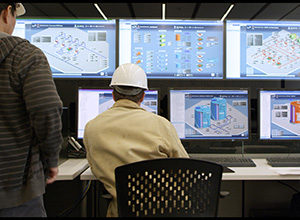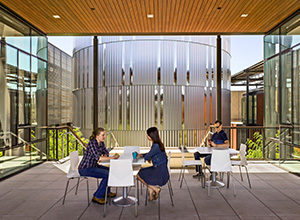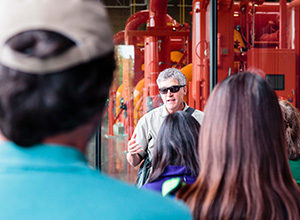In one of the most innovative capital projects undertaken at the university to date, Stanford has taken on the issue of climate change, perhaps the greatest environmental and socioeconomic challenge of our time, to lead by example and raise the bar in efficiency and ingenuity.
The Stanford Energy System Innovations (SESI) project transformed the campus energy supply from one based on fossil fuels to one powered by renewable electricity designed to meet the university’s future energy needs while reducing greenhouse gas (GHG) emissions and water consumption. SESI has already reduced potable water consumption by 18%, and by the end of 2016, it will reduce campus GHG emissions by 68%, making Stanford one of the most energy-efficient research universities in the world.
The project has received international recognition for its innovation, design, and efficiency, and will continue to achieve reductions and savings as the university explores options to attain carbon neutrality in its power supply. SESI is seen as a model for energy supply systems at a large scale. It has received numerous awards, including the highest environmental honors of the State of California, Engineering News-Record, and the American Institute of Architects.

Control room of the CEF
The main component of SESI is a new Central Energy Facility (CEF) that utilizes heat recovery to be significantly more efficient than the previous cogeneration process. Chilled water is sent out to campus for cooling needs and returns at a warmer temperature via a chilled water loop. Heat recovery chillers at the facility extract this excess heat collected from buildings for reuse in a new hot water loop, which has replaced Stanford’s aging steam system. This new process not only is safer and reduces heat loss from the steam system, but also minimizes the need for conventional chillers to discharge waste heat via cooling towers. The plant features both hot and cold water thermal storage and relies on a diversified mix of electricity sources to create a more environmentally and economically sound power portfolio. Operational since April 2015, SESI encompasses the best of both North American and European district heating and cooling system advances, with engineers, manufacturers, and builders from both continents collaborating with experts across campus to develop this state-of-the-art transformation of Stanford into one of the most efficient district energy systems in the world.
SESI is the primary strategy in Stanford’s Energy and Climate Plan, originally developed in 2008, which also includes high efficiency standards for new buildings and continued efficiency improvements for existing buildings. Although developed independently by Stanford from 2009 to 2011, SESI may be the first large-scale example in the world of the technology roadmap for building heating and cooling recommended by the International Energy Agency, which the United Nations Environment Programme discussed in a comprehensive report on district-level implementation.
Results
Since coming online in April 2015, the SESI project has already yielded significant savings for the university. Specific benefits include the following:
- In its first full year of operation, the CEF reduced Stanford’s GHG emissions by approximately 63,500 metric tons,1 a 35% reduction from the previous year. This reduction will continue to increase as the renewable component of Stanford’s electricity supply comes online, and by the end of 2016 it will reach 68%.
- The electricity-dependent energy supply system offers greater reliability, lower cost, and more flexibility for additional green power procurement. By the end of 2016, the 67-MW Stanford Solar Generating Station will be fully operational, along with photovoltaics on 16 sites across campus, for a 65% renewable electricity supply.
- Since the majority of the waste heat from the chilled water loop is reused, rather than discharged via evaporative cooling towers, the CEF saved 127 million gallons of campus potable water in its first year, a 67% reduction compared to average operations of the previous plant.
- The $485 million capital investment in SESI represents a significant transformation of the university energy supply from fossil-fuel-based cogeneration to a more efficient electric heat recovery system. SESI was the best-cost option compared to continuation of the cogeneration system, with a net additional $100 million capital investment projected to yield $450 million in savings over the next 35 years.

Staff working on CEF patio
The Department of Sustainability and Energy Management operates the CEF with a new automated control system, Enterprise Optimization Solution (EOS), a patented technology invented at Stanford and developed for commercial use by Johnson Controls, Inc. EOS assures optimal operation through predictive economic dispatching based on load and market electricity pricing forecasts. It allows fully automated operation to eliminate guesswork in running a complex combined heating and cooling system with both hot and cold thermal storage, and has been shown to increase efficiency an average of 6%.
Using EOS and an 8760 model—an hourly projection of energy needs for the year—Stanford has consulted with numerous local, state, national, and international entities to model the opportunities for district-level heat recovery in various locations and climates. The calculations have proven that district-level heat recovery with thermal storage can be successful in a variety of climates and facility types.
Academic Integration
SESI continues to serve as a living laboratory to engage the campus community and the public at large by exemplifying a path toward sustainable energy. Biweekly tours allow visitors to interact directly with the mechanical systems that allow the CEF to operate, and to date more than 2,000 people have toured the facility, including university classes and conferences; government delegations from the United States, France, and Taiwan; and private sector organizations such as Google and Tesla.
Throughout implementation of the SESI project, details were extensively peer reviewed by faculty, as well as a Board of Trustees advisory committee. SESI program studies have also periodically engaged graduate student researchers to supplement industry findings, verify models, and assist with other assessments.

Tours of the Central Energy Facility are offered twice monthly to the campus and community
Stanford staff will continue to partner with students and faculty to utilize the CEF as a living laboratory, where students can directly interact with the technical operations of the university. The CEF features communal space for classes and meetings for both Stanford students and members of the surrounding community. By helping educate tomorrow’s workforce, SESI is ensuring that these trained professionals can meet the demands of the world’s growing clean energy sector.
Looking Ahead
Studies of additional potential enhancements to the campus energy system have begun. These include:
- Development of a ground source heat exchange system to complement the core heat recovery process;
- Installation of a new high-voltage transmission line to improve the reliability of the grid that serves the university; and
- Installation of a natural gas–based centralized emergency generation and distributed electrical storage system to replace the current distributed diesel fuel emergency generation system.
The university also plans to develop a central utility plant for its Redwood City campus and will incorporate elements of the SESI program at that campus to achieve the most sustainable results possible.
